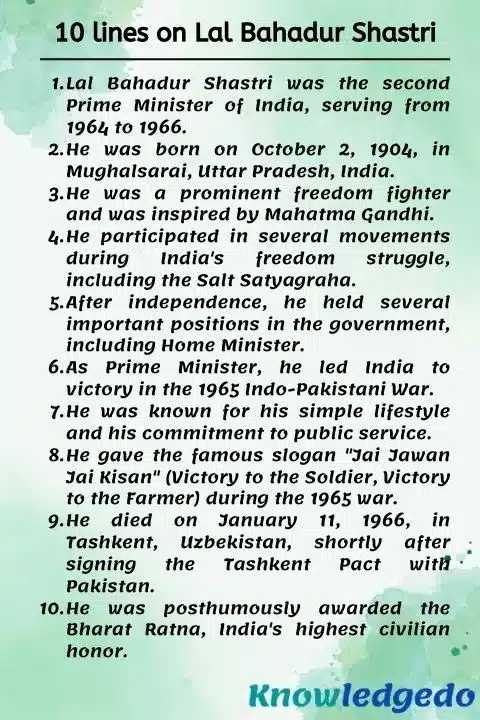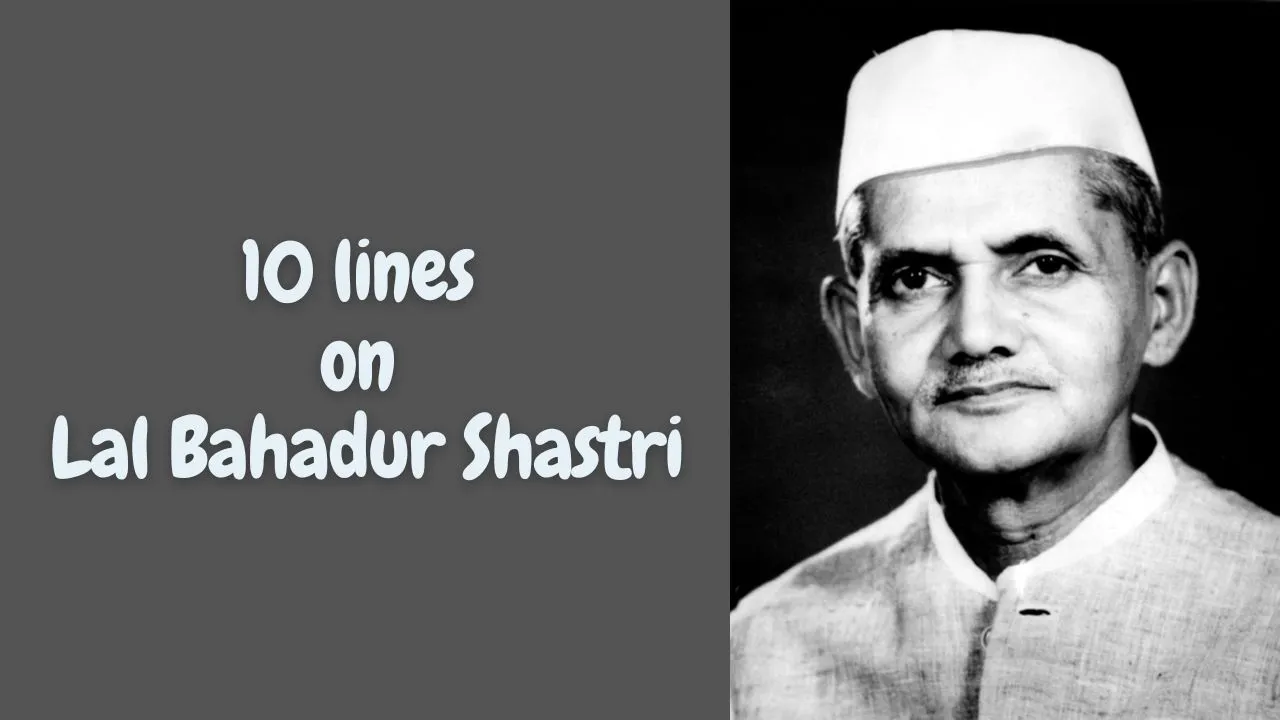Today, we are sharing 10 lines on Lal Bahadur Shastri in English. This article can help students who are looking for information about 10 lines on Lal Bahadur Shastri. These lines are straightforward and easy to remember. The level of difficulty is moderate, making it accessible for any student to write on this topic.
This article is generally useful for class 1,class 2,class 3,class 4,class 5,class 6,class 7,class 8,class 9,class 10,class 11,class 12
10 lines on Lal Bahadur Shastri
1) Lal Bahadur Shastri was the second Prime Minister of India, serving from 1964 to 1966.
2) He was born on October 2, 1904, in Mughalsarai, Uttar Pradesh, India.
3) He was a prominent freedom fighter and was inspired by Mahatma Gandhi.
4) He participated in several movements during India’s freedom struggle, including the Salt Satyagraha.
5) After independence, he held several important positions in the government, including Home Minister.
6) As Prime Minister, he led India to victory in the 1965 Indo-Pakistani War.
7) He was known for his simple lifestyle and his commitment to public service.
8) He gave the famous slogan “Jai Jawan Jai Kisan” (Victory to the Soldier, Victory to the Farmer) during the 1965 war.
9) He died on January 11, 1966, in Tashkent, Uzbekistan, shortly after signing the Tashkent Pact with Pakistan.
10) He was posthumously awarded the Bharat Ratna, India’s highest civilian honor.

5 lines on Lal Bahadur Shastri
1) Lal Bahadur Shastri was the second Prime Minister of India.
2) He was a freedom fighter and was inspired by Mahatma Gandhi.
3) He led India to victory in the 1965 Indo-Pakistani War.
4) He was known for his simple lifestyle and his commitment to public service.
5) He gave the famous slogan “Jai Jawan Jai Kisan” (Victory to the Soldier, Victory to the Farmer).
FAQ
Answer: Lal Bahadur Shastri was the second Prime Minister of India, serving from 1964 to 1966. He was a prominent freedom fighter and was inspired by Mahatma Gandhi. He participated in several movements during India’s freedom struggle, including the Salt Satyagraha. After independence, he held several important positions in the government, including Home Minister. As Prime Minister, he led India to victory in the 1965 Indo-Pakistani War. He was known for his simple lifestyle and his commitment to public service.
Answer: Lal Bahadur Shastri’s most notable achievements include:
~Leading India to victory in the 1965 Indo-Pakistani War
~Introducing the Green Revolution, which helped to boost India’s food production
~Implementing the White Revolution, which helped to improve India’s milk production
~Promoting the use of Hindi as the national language of India
~Advocating for simple living and high thinking
Answer: Lal Bahadur Shastri died on January 11, 1966, in Tashkent, Uzbekistan, shortly after signing the Tashkent Pact with Pakistan. The cause of his death is still disputed, but it is believed that he suffered a heart attack.
Answer: Lal Bahadur Shastri is remembered as a great leader who dedicated his life to the service of the Indian people. He was a humble and down-to-earth man who was loved and respected by all. He is also credited with playing a key role in India’s economic development.
Lal Bahadur Shastri is an inspiration to many people, both in India and around the world. He is remembered for his simplicity, honesty, and dedication to public service. He is a true role model for leaders everywhere.
